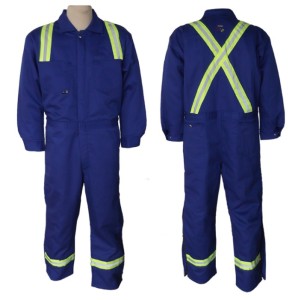Choose one of the sub categories below:
ELECTRICAL SAFTEY
Arc Flash PPE
Arc Flash Personal Protective Equipment Saves Lives


The proper arc flash personal protective equipment (PPE) is essential necessity when an electrician faces danger of being harmed by an arc flash. This flash can occur any time an electric arc is provided with enough electricity to cause injury, harm or fire. Electrical arcs sustained by controlled energy and in restricted amounts are used in welding and other industrial applications.
The temperature on arc flashes can reach, and in some cases surpass 35000°F (20000°C) at the arc terminals. The enormous release of energy in the fault will vaporize the metal conductors quite rapidly, resulting in molten metal blasting and expanding plasma outwards with great power.
Usually arc flash incidents are insignificant, that means no harm comes to the electrician, especially when wearing relevant arc flash personal protective equipment, but it is possible for a flash to produce an extreme blast. In such circumstances equipment is ruined, a fire can start and laborers are most likely injured. Not just the one involved in the accident, but any one in reach as well.
Notwithstanding the dangerous impact of an arc flash, considerably more damage can emerge from the extreme heat the circular segment produces. The metal plasma arc is able to create a huge volume of light energy that can vary from ultraviolet to far infrared. The surface of any close-by object is instantly heated to extreme temperatures, including people, which leads to devastating consequences.
Keeping Yourself Safe
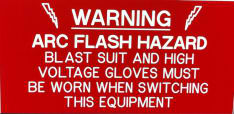 The most crucial part of any job is personal safety. There are few approaches to secure Yourself from an arc flash risk, including wearing approved arc flash PPE or changing the outline and configuration of the electrical equipment you are working with.
The most crucial part of any job is personal safety. There are few approaches to secure Yourself from an arc flash risk, including wearing approved arc flash PPE or changing the outline and configuration of the electrical equipment you are working with.
The best approach to eliminate the possibility of an arc flash hazard is to separate the electrical power when working with electrical gear. On the other hand, the act of de-energizing the equipment can also be a jeopardy.
One of the most up to date solution for the particular problem is to have the worker operate the equipment remotely, allowing him/her to be situated as far away from the gear as possible. Thus, if an incident does happen, no one will get injured.
What Exactly is the Arc Flash PPE?
There are number of companies offering arc flash personal protective equipment (PPE), arc flash training and arch flash video tutorials. All materials used in its production must have been tested to establish their arc rating, which depicts the maximum amount of energy it can withstand. It is generally portrayed as cal/cm² (small calories of heat energy per square centimeter). Modacrylic-cotton blends are among the best fabrics to protect against arc flash risks. It is important to use the right PPE for the task You must do. You can find out what You should wear in NFPA 70E under the hazard classification table.
The table shows most of the electrical tasks You are likely to encounter, according to voltage level, and what type of PPE you should wear, by class. For instance, say You are assigned to work on a 600 V switchgear where You will have to remove the cover, and expose bus bare, live parts, the table recommends wearing a category 3 PPE system. This framework is made up of several pieces of protective clothing that combined will provide up to 25 cal/cm² of protection.
Arc Flash Clothing / Suit
Category 3 PPE system includes:
- Cotton underwear
- Natural fiber short sleeved T-shirt
- Pants and long sleeved shirt (must be arc rated)
- Coveralls over Your apparel (must be arc rated)
- 25 cal arc rated arc flash jacket and pants
- 25 cal arc rated arc flash hood
- hard hat
- safety glasses
- hearing protection
- insulated gloves with protectors (must be arc rated)
- leather shoes
Arc flash PPE is formed to protect You in case an arc flash incident occurs, and should thus be considered as the last line of defense. It is always better to do everything possible to reduce the likeliness of an incident occurring in the first place, or at least restricting the severity of the calamity. This can be accomplished by thoroughly evaluating the arc flash hazard and using high-resistance grounding technology, which has shown to dramatically restrict the severity and frequency of incidents.
[qs_widget wtpl=”onestep” sub=”ELECTRICIAN” frameheight=”120″ framewidth=”670″]
Electrician Coveralls
Fire Retardant Coveralls for Electricians
 For electricians fire retardant coveralls are as an important personal item as the electrician tools. Depending on the work environment, they may be may be compulsory equipment. Fulfilling Your work obligations in dangerous environments requires You to wear certain personal fire retardant clothing. An arc flash event is a kind of explosion caused by high voltage. Wearing the proper protection can prevent a little incident from turning into a disaster.
For electricians fire retardant coveralls are as an important personal item as the electrician tools. Depending on the work environment, they may be may be compulsory equipment. Fulfilling Your work obligations in dangerous environments requires You to wear certain personal fire retardant clothing. An arc flash event is a kind of explosion caused by high voltage. Wearing the proper protection can prevent a little incident from turning into a disaster.
Diverse Types of Coveralls
Majority of employers are going to supply You with the proper safety equipment, but if You are an independent contractor, You may have to purchase the gear yourself (note that there still are some companies that are providing independent contractors with the safety equipment as well).
Do not reduce quality requirements when it comes to safety equipment. Saving a couple of dollars on a cheap pair of coveralls can end up costing You much more in the long term. First of all, they will not last as long as higher quality manufacturing, so You will be buying a new pair in no time. Secondly, if You do have an accident, You could lose several job opportunities while recovering at home or hospital from trauma.
Fire Retardant Coverall Buying Tips
In case You are not able to find a safety supply store close-by, You can definitely shop online. Actually, it is more advisable as there are several reputable companies selling safety coveralls for the best prices. The amplitude ranges from $100 to $300 depending on the brand, durability and technical features. Make sure to purchase”Cal” rated fire retardant coveralls.
As You may notice, there are some extra heavy-duty coveralls that cost well over a $1000, but as an electrician, You will probably not need that type. A good pair around the $150 mark ought to do the job quite nicely and last long.
Weight of apparel should be taken as factor when choosing one. You do not want a pair that will hinder work, instead, You want a pair that will ensure sufficient protection, but still be comfortable enough to wear throughout the day. Coverall must be be lightweight and flexible. Electricians often find themselves in confined space. The last thing You need is huge and massive coveralls that make it impossible to get to the issue area.
Storing Your Coveralls
You might come across various situations and circumstances that do not require the extra protection of coveralls. In such cases, always store your safety gear in a dry and safe place. Provide them a thorough cleaning prior storage and fold them neatly.
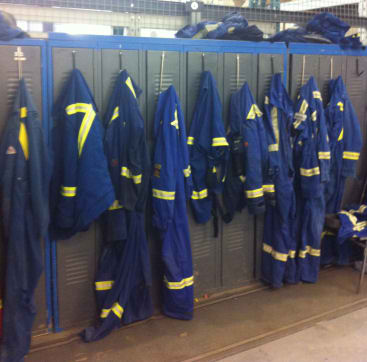
Most likely You want them to be prepared for usage when such need appears. You do not want to pull them out to discover they have been contaminated by chemicals, mud, dirt, infested with bugs, or started rotting.
Mostly fire retardant coveralls are produced of nylon or cotton. The inner layer is designed from cotton to provide user with extra comfort and the outer layer is for protection. The clothing is treated with high quality, fire resistant chemicals that are deeply impregnated into the fibers. These chemicals have been formed to extinguish a source of ignition, to prevent a spark from transforming into a flame.
High quality safety gear can cost a fortune, so You want to take good care of them. With proper care, it should last several years. They come in a wide color range, but the most popular are navy and royal blue, orange, white and khaki. Most fire resistant clothing can be washed in a regular washing machine – just carefully follow the instructions on the label and never use bleach, as it may interfere with the fire resistant chemicals. The most importantly, never put them in the dryer (unless the label specifically says You can do that). Just let them hang to dry out.
Industry Standards
For electrical laborers, fire resistant clothing is regulated by the National Fire Protection Agency standard 70E. It declares that employees must wear flame resistant protective clothing whenever there may be a threat of exposure to an electrical arc flash. For industrial electricians working in the oil patch can expect to wear full body fire resistant apparel everyday.
Abiding by the standard is currently voluntary, and most organizations do comply. It is the generally accepted safety standard throughout the electrical industry.
The general duty clause of the Occupational Safety and Health Association (OSHA) declares that all employers must take all necessary precautions to ensure laborers are protected and their environment is as safe as possible. Organizations found not to comply are fined.
When working with electricity, whether You are an apprentice or an experienced master electrician, there is and always will be a high risk of an arc flash land on your clothing. Remember to protect yourselfwith a proper fire resistant outfit at all times to prevent a tiny incident from transforming into a serious calamity.
Fire Retardant Clothing (FRC Clothing)
Fire retardant apparel is chemically treated to decrease the possibility of catching on fire. There are many types of clothing available, exactly which ones You need depend on the type of work You do. Fire fighters, for instance, need to be protected from head to toe, including fire resistant boots.
Most electricians must have fire proof sleeves and coveralls or aprons. The biggest threat of Your clothing catching on fire comes from an arc flash – it can start a fire or cause severe burns. As Your arms and chest area are at the greatest risk, fire resistant sleeves and aprons protect these parts of body. They are worn right over regular clothing, making it easy to slip them on and off.
Safety standardsare in composed to inform You about what type of protection You need for each type of job. There are many companies that make high quality personal safety clothing. Your local safety store will have several brands available, or you
Rasco FR Khaki Henley T-Shirt 100% Preshrunk Cotton NFPA 2112 Large
can shop online
for a wider selection and better prices!
Fire Resistant Clothing
As an employee of an enterprise, you may have not only electrician tools supplied to You, but the safety equipment as well. However, there are companies that require You to buy certain items from Your electrician salary . Since individuals come in wide range of shapes and sizes, it is easier for the company to have You buy Your own coveralls or other fire retardant clothing and then reimburse You the money, rather than order the apparel for You.
Shopping for the Fire Resistant Apparel
When purchasing no matter what kind of safety equipment, whether You will be reimbursed or not, do not sacrifice quality for a cheaper brand ( Rasco FR Khaki Henley T-Shirt 100% Preshrunk Cotton NFPA 2112 Large shop good brands online for adequate price). Saving a few dollars can cost You a lot in the long run. For instance, lower quality means that equipment is likely to have shorter utilization period before it gets outworn. There might be cases that cheaper brand will not provide adequate protection you need.
Another important aspect that has to be taken into the consideration is the weight of particular apparel. You need to obtain adequate level of protection, but do not want additional obstacles when doing your job. In case You are weighed down with bulking clothing You will tire out faster and You might be unable to perform some of Your job obligations properly. In other words, proper safety clothing must be lightweight, allowing to move freely.
FR Clothing Outfit Storage and Proper Care
There will definitely be time You do not need all Your personal safety gear. Outfit storage and proper care is extremely important. Throwing the gear in the corner of Your locker, especially when wet, can ruin it. You should always fold it neatly or hang it up, and, of course, make sure to give them a thorough cleaning inspection prior and after each use. The last thing You want is to discover that Your safety equipment has been ruined by chemicals.
Majority of fire retardant apparel is produced of nylon or cotton. The inner layer is designed from cotton to provide user with extra comfort and the outer layer is for protection. The clothing is treated with high quality, fire resistant chemicals that are deeply impregnated into the fibers. These chemicals have been formed to extinguish a source of ignition, to prevent a spark from transforming into a flame.
Highest quality safety gear can cost a fortune, so You want to take good care of them. With proper care, it should last several years. They come in a wide color range, but the most popular are navy blue, royal blue and orange.
Most fire resistant clothing can be washed in a regular washing machine – just carefully follow the instructions on the label and never use bleach, as it may interfere with the fire resistant chemicals. The most importantly, never put them in the dryer (unless the label specifically says You can do that).
Industry Standards for Fire Retardant Clothing
For electrical laborers, fire resistant clothing is regulated by the National Fire Protection Agency standard 70E. It declares that employees must wear flame resistant protective clothing whenever there may be a threat of exposure to an electrical arc flash. For
industrial electricians, auto electricians and oil rig electricians
working in the oil patch can expect to wear full body fire resistant apparel everyday.
Abiding by the standard is currently voluntary, and most organizations do comply. It is the generally accepted safety standard throughout the electrical industry.
The general duty clause of the Occupational Safety and Health Association (OSHA) declares that all employers must take all necessary precautions to ensure laborers are protected and their environment is as safe as possible. Organizations found not to comply are fined.
OSHA is currently working towards rewriting their standard in order to cover all maintenance and operations of electrical power generation, transformation, transmission, control and distribution of electrical power lines and electrical equipment to reflect the standards described in NFPA 70E. Once the standard is approved, compliance will be law and thus no longer voluntary.
When working with electricity, whether You are an apprentice or an experienced master electrician, there is and always will be a high risk of an arc flash land on your clothing. Remember to protect yourselfwith a proper fire resistant outfit at all times to prevent a tiny incident from transforming into a serious calamity.
Electrician Vest
Probably the first time You will get a closer look upon a safety vest will be during electrician courses or an electrician apprenticeship program. A safety vest must be worn in a variety of occupations and occasions – whenever You need to be seen. Nevertheless, not every safety vest is suitable for all working environments. Just like with any other type of personal safety equipment, You need a vest designed for your particular job. Vests are classified according to the amount of reflective material on the surface of clothing.The color of the vest does not influence ratio, however, it is extremely important that You know which classification Your job requires and to purchase the right vest for the job.
Picking the Vest
Aside from the diverse classifications, safety vests likewise come in a variety of styles. These styles include adjustable vests, safety jackets, breakaway vests and the economy vest. One style may work better in certain conditions. Make sure You choose the right one for Your particular needs and that complies with the safety guidlines of Your organization. There are number of occupations that demands You to be seen; with new rules and regulations, just about every city labourer has to wear a vest. This is mainly because far too many workers have been injured on the job.
Occupational Safety and Health Administration (OSHA) Standards for Wrokplace Vests
OSHA vest requirements vary by the sort of action You perform.
An OSHA vests categorized as an ANSI II or an ANSI III are inteded to help You be seen when operating heavy equipment or hazardous machinery.
In case You work for the city or county, employer will most likely to provide You with all the neccessary safety equipment. Many other employers outfit You with the proper safety gear, as well. But if You do have to buy your own safety gear, you will probably find the best deals online. The best variety and prices are available in amazon.com.
Generally, safety vests are available in orange, green and blue, are highly visible, and feature a special reflective quality. O
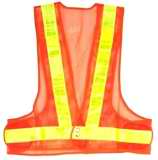 range reflective vests are used in high traffic areas, they help vehicle drivers to notice You when You have to work near moving vehicles and other heavy machinery. Blue vests are typically worn by emergency personnel. They differentiate emergency workers from policemen or firemen. Even though all three are emergency workers, each has a different responsibility. The blue vest inform others that You are in the healthcare area.
range reflective vests are used in high traffic areas, they help vehicle drivers to notice You when You have to work near moving vehicles and other heavy machinery. Blue vests are typically worn by emergency personnel. They differentiate emergency workers from policemen or firemen. Even though all three are emergency workers, each has a different responsibility. The blue vest inform others that You are in the healthcare area.
Vest Categories
For a safety vest to obtain a Class II or Class III rating, it must meet certain criteria that include how much reflective material it contains, how much background material and whether it has sleevs or is sleeveless.
- Class II – people operating large machinery or working around heavy traffic areas with speed limits of 25 to 50 mph, need this type of vest. If Your job does not have a specified vest requirements and therefore You are left to choose one for Yourself, you should go for a Class II or Class III as these will provide much more visibility than the economy model. The ANSI regulations state a class II vest must have retro-reflective material measuring 201 square inches, in addition to 1.375 inches of reflective stripping. Also, there must be 775 square inches of background material and must be sleeveless.
- Class III – This class provides more visibility than Class II. It has sleeves, 1240 square inches of background material, 310 square inches of reflective material and 2 inch striping. This type is a mandotory choice for people working close to traffic traveling at speeds in excess of 50 mph.
- ANSI 207 safety vests – This is a special purpose vest, specially designed for public service workers, such as policemen, emergency response workers, fire fighters, and many other types city labourers.
- Economy class vests – Look into the details of this type of vest if You come across it on the internet. Some online stores use this term to describe cheap vests. Read the description carefully before purchasing this category of vest.
Adventages of an Adjustable Vest
In most working conditions how well your safety vest fits is not an issue. All that really metters is that You are visible to others. However, as an electrician from time to time is required to work in confined space, the last thing You want is that Your vests gets stuck on protruding objects. Therefore, a snug fit could be much safer. On the other hand, work outdoors means facing all sorts of weather – when its warm/hot, You will be glad to wear light clothing, when its cold or rainy, You will be glad to have warm clothing or something waterproof.
As buying differently sized vests for all possible circumstances might be quite costly, adjustable vest is a perfect solution. You can cinch the vest tight when You are wearing light clothing in warm weather or expand it to accommodate winter wear. From employer perspective adventage for choosing an adjustable vests is that they accommodate workers of all shapes and sizes. It will save a lot of money in case of employees losing/gaining weight, employee rotation (leaving and joining the company) and that in particular case vests can be bought in bulk (possible discounts).
References:
OSHA and Vest Standards
ANSI and Vest Standards
Electrical Safety Gloves / Lineman Gloves
If You wonder why do electricians need safety gloves, the answer is quite simple – working with electricity is extremely dangerous. You must always make sure not only to use the most appropriate electrician tools, but also to wear the right safety equipment, including gloves. Rubber insulating gloves are probably the most important personal protection an electrician can wear. Gloves must combine high physical endurance and dielectric qualities, along with durability and flexibility. For the best execution, the gloves should meet (or exceed) American Society for Testing and Materials requirements and specifications. The safety gloves should also pass ASTM D120/IEC903 electrical tests and specifications.
The Rule of Tthree
Preferably, an electrician (or an apprentice) should wear 3 types of safety gloves while working with electricity. This may sound unreasonable, but it guarantees safety. These are:
- Rubber Insulating Gloves – these are classified by how much voltage the gloves can protect against and the level of protection they can ensure. It is not mandotory to always wear insulated gloves. While working on non-energized equipment, kevlar gloves are the ultimate choice. They provide the best protection from scratches, cuts and abrasions.
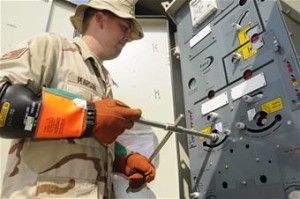

- Liner Gloves – these are used to deminish the level of discomfort that sometimes is caused by rubber insulating type gloves. They can be used under all waether circumstances, all year round. The liners keep you warm in low temperatures and absorb sweat on hot days. They are usually made with a straight sleeve or a knitted wrist.
- Leather Protective Gloves – these are intended to be worn over top of rubber insulating safety gloves. They provide additional protection against cuts, scrapes and punctures. Check to get the steam pressed type with curved hand forms. These provide a much better fit over the rubber safety gloves.
Characterization of Electrical Safety Gloves
Electricians have to work with or close to live electrical currents most of the time. This places each and every of them in constant jeopardy of electrical shock/electrocution. Wearing the proper personal protective gear is essential.
The Occupational Safety and Health Administration (OSHA) has clear guidelines outlining the design, care and proper use requirements for all electrical safety equipment. This includes insulating gloves, sleeves, blankets, mats, covers and hoses. Electrical grade protective gloves are classified by how much voltage they can protect against and whether or not they are ozone resistant.
Voltage protection levels are devided into following classes:
- Class 0 – Provides for a max of 1k volts AC, and is proof tested to 5k volts AC.
- Class 1 – Provides for a max of 7,5k volts AC, and is proof tested to 10k volts AC.
- Class 2 – Provides for a max of 17k volts AC, and is proof tested to 20k volts AC.
- Class 3 – Provides for a max of 26,5k volts AC, and is proof tested to 30k volts AC.
- Class 4 – Provides for a max of 36k volts AC, and is proof tested to 40k volts AC.
Download this PDF which explains the safety ratings of the different classes of gloves.
Ozone resistance for safety gloves is covered under the “Type” designation. Type I gloves are not ozone-resistant, wihile Type II gloves are.
OSHA demands that all safety equipment must be properly maintained and kept in a safe and reliable condition. This implies that all rubber insulating safety gloves must be checked every time before using them.
You must also fully inspect the gloves after an incident where they might have been damaged.
In most cases, the employer will demand You to throw out the gloves after an accident, as the employer carries great responsibility towards employees and their health. In addition, all insulating gloves must have an air test as part of the regular inspection. OSHA does not clarify how exactly this test should be performed, however, you can find the proper testing method in ASTM F 496.
 It states that individual should fill either manually or with an inflation tool the gloves with air, and then check for leaks – either by listening closely for air escaping or by feeling the air leaking out.
It states that individual should fill either manually or with an inflation tool the gloves with air, and then check for leaks – either by listening closely for air escaping or by feeling the air leaking out.
Do not inflate the glove more than 1.5 times its normal size for a Type I safety gloves; not more than 1.25 times its normal size for Type II gloves. The air test should be repeated with the gloves turned inside out.
In addition to this routine testing, it is recommended that all electrical safety equipment be electronically tested about 2 a year. If the equipment has not been utilized for long period of time, it should have a careful electrical test and thorough physical examination before use.
Examining Your Safety Gloves
In order for Your gloves and sleeves to be able to provide the necessary protection, they have to be well cared for and properly stored at all times between use. Your pre-use check up should include checking for all types of possible damage – holes, tears, rips, ozone cuts, UV damage and any signs of possible chemical damage or deterioration. If You think Your equipment might have been contaminated or suffers from any type of damage,turn it to supervisor or safety inspector for a thorough physical inspection, good cleaning and electrical inspection.
Electrical fety gloves and other safety equipment is quite expensive. Many employers provide these for You, but in case You have to buy them yourself, temptation to cut corners might appear.This is not a good idea, spending a few extra dollars can save from serious injuries, or worse. You might think the leather protective safety gloves are a waste of money and may be tempted to just buy the rubber gloves. The rubber gloves provides insulation, however, to obtain protection from injuries like cuts and scrapes leather safety gloves are required You will also want the liners for extra comfort.
Look for Standards Before You Buy
Always buy safety gloves and all other safety equipment from a reputable manufacturer and make sure they comply with OSHA regulations and standards.
References:
OSHA glove standards
ANSI hand protection standards
>
Electrician Boots / Footwear
Industrial Safety Boots / Footwear For Electricians
 Industrial safety footwear is a crucial part of equipment for anyone working in an industrial environment. Regardless of how cautious You and evenryone around are, accidents occur. You may drop something or accidentally step on something edgy. This could put You out of work for several weeks or month, not to mention all of the pain you will have to endure. Since a big portion of work day will be spent on Your feet, it is extremely important to keep the feet safe, dry and comfortable. Safety shoes are designed to provide every aspect stated above. Of course, some are more comfortable than others, some are more fashionable than others, as well.
Industrial safety footwear is a crucial part of equipment for anyone working in an industrial environment. Regardless of how cautious You and evenryone around are, accidents occur. You may drop something or accidentally step on something edgy. This could put You out of work for several weeks or month, not to mention all of the pain you will have to endure. Since a big portion of work day will be spent on Your feet, it is extremely important to keep the feet safe, dry and comfortable. Safety shoes are designed to provide every aspect stated above. Of course, some are more comfortable than others, some are more fashionable than others, as well.
As long as the footware You choose meet the safety guidelines of your job, You can choose any pair You like the most.
As an apprentice or trained electrician, you are aware that ecletricity must have a complete circuit to continue its flow. Without appropriate footwear, You may be the ground the circuit needs to complete this flow. When electricity does not have a point of entry and a point of exit, then one does not have to worry about an electric shock. This is why a bird can comfortably sit on a high voltage power line without risk of shock (animal has contact with the circuit at one point only).
Working With Electricity
Despite the fact that both feet are touching the wire, they are touching it at the same point, which implies there is no current going through the bird’s body. If You could float up to the electricity wire and grab on it, You would not get any shock either. In practice You need a ledder or an aerial basket to get to the wire, so this equipment completes the circuit.
Now, You are probably wondering that You will not be bare foot when touching the wire. Your rubber soled shoes are insulators, so You should be safe, correct? Rubber soled shoes do provide some insulation from electrical shock. But the average shoes are not designed to be electrically safe – soles are simply too thin and the rubber is not up to electrical safety grade standards. In addition, the shoes may have dirt, moisture or body sweat inside and outside of them. This further compromises any insulating properties they may have had. Usual footwear is just not sufficient protection when working with high voltage.
Electrically Safe Footwear
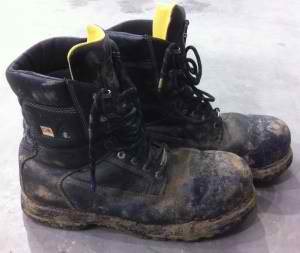 Industrial safety footwear comes in various styles and fashions, they are also categorized for different types of industry. Safety boots are durable boots or shoes fortified with a defensive steel toe that protects Your foot from falling items or from being squished. The boots typically have a strong mid plate that ensures the soles of Your feet from punctures, in case You step sharp, edgy objects like nails. Generally, the reinforcements are crafted of steel, but these days they may as well be made of composite materials, thermoplastic polyurethane or aluminum.
Industrial safety footwear comes in various styles and fashions, they are also categorized for different types of industry. Safety boots are durable boots or shoes fortified with a defensive steel toe that protects Your foot from falling items or from being squished. The boots typically have a strong mid plate that ensures the soles of Your feet from punctures, in case You step sharp, edgy objects like nails. Generally, the reinforcements are crafted of steel, but these days they may as well be made of composite materials, thermoplastic polyurethane or aluminum.
 Wearing safety boots is obligatory in most manufacturing plants and on construction sites. Since electricians are trained and required to work at different locations, they must wear electrical grade safety boots whenever they are at work. In most jurisdictions, these boots must be fully certified, and show the certification right on the side of the boot.
Wearing safety boots is obligatory in most manufacturing plants and on construction sites. Since electricians are trained and required to work at different locations, they must wear electrical grade safety boots whenever they are at work. In most jurisdictions, these boots must be fully certified, and show the certification right on the side of the boot.
Industrial safety footwear comes in various cool designs, including running shoes and clogs. You can even get safety shoes that look like dress shoes. These type of shoes are popular with supervising engineers especially when overseeing certain projects, or visiting construction sites where safety shoes are compulsory.
Some high fashion designers like Grinders and Dr. Martens have also entered into the safety shoe bandwagon – many of their safety shoes have attracted a cult following from among the younger individuals.
[qs_widget wtpl=”onestep” sub=”ELECTRICIAN” clr=”red” frameheight=”120″ framewidth=”670″]
Common Safety Clothing Symbols
For a simple identification, most industrial safety footwear have symbols on the side of the shoe or boot to show its grade or classification. For instance:
- Green triangle – class 1 toe protection and sole protection. Suitable for heavy industry such as machine shops and construction sites
- Yellow triangle – lass 2 toe protection and sole protection. Graded for light industries
- White square with the ohm symbol inside – this is the electrician’s safety boot, wherein the sole is capable to have resistance against electric shock. These are genereally used at any point where possibility of live electrical conductivity exists
- Red triangle with a black C and grounding symbol – it means positive electrical conductivity of the soles. These are used in industrial environments where the presence of low electrical charges presents hazard to machinery or workers
- Fir tree or white label with a symbol of fir tree inside – sed by forestry workers and others that use chainsaws
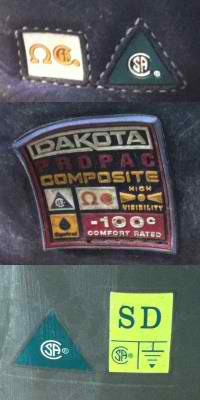 Blue square – class 1 toe protection only. Used in environments other than the ones listed above.
Blue square – class 1 toe protection only. Used in environments other than the ones listed above.
For most plant workers, industrial safety footwear with a categorization of green, yellow or blue are all the protection they require. Trained electricians , on the other hand, should always wear the white grade with the ohm symbol. These shoes will lessen the danger of electrical stun, and quite possibly spare life.
You will never deliberately place Yourself in peril or snatch a live wire, yet accidents do occur. Why not take additional precaution and wear the proper footwear for Your job? Although the industrial safety footwear is quite expensive, but if it can save you life, it is worth the cost!


